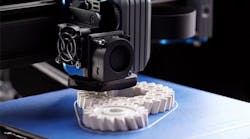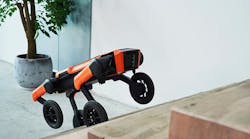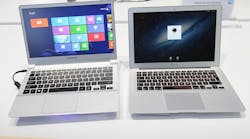Enhancing human performance has been a perennial goal of mankind to get more out of the time 'we' as a species have to explore life.
While the goal of enhancement is to get more out of the time we have, sci-fi thrillers such as “The Terminator,” “I, Robot” or even Marvel’s “The Avengers, Age of Ultron” play on our duality of obsession and fear of a world dependent on technology.
Regardless of our personal connection with technology, the unalterable fact remains that technology is and will continue to transform the world.
This is no more evident, than the human technology balance of the workplace.
Bionics refers to the substitution of common human activity with engineered systems and technology. It is more commonly associated with the electro-mechanical substitution or material enhancement of the human body.
Continuing with the science adventure, theme; Tony Stark enhanced his capabilities using an extreme exoskeleton becoming Iron Man. The exo-enhanced soldier is in progress but the more practical enhancements for workplace bionics is already in place, and it's been improving the cost and performance of business for years.
Employees working for nearly every modern company – millennials especially – are already enhanced with bionics; mobile and wearable computing.
The Age of Bionic Employees has arrived, and the corporate ecosystem has been headed in this direction since the Second Industrial Revolution catapulted us forward with the telephone and typewriter.
Where and when employees work and how they communicate is directly integrated with the technology a company chooses to employ.
While not everyone is onboard with incorporating mobile technology into the business model of a company, it’s time for business decision makers of all sizes to make a choice – integrate fully enhanced bionic employees with mobility as key assets or have your interests plateau with the value of the paycheck.
Are Bionic Employees (BE) Potential Dynamos or Just a Distracted Drag on Productivity?
Multi-tasking is an illusion. Rather it is capacity to quickly switch between short spurts of high focus rather than the ability to actually perform multiple activities simultaneously.
Everyone has their limited primary focus area and does their best to manage the distractions constantly pulling at that limited capacity. While distractions at home may drift between personal interests, there are only 24 hours in a day with about 40 percent of that time in the workplace.
During the workday, the technology in our pockets – a bionic integration with life – can serve as an asset significantly increasing productivity. However, BEs need a new workplace if a company hopes to get a full day’s productivity by integrating into their full bionic routine.
As the lines between physical and digital blurs, mobile technology means more flexibility for workers as well. Some workplace fundamentals for BEs to contribute effectively should include:
- A workplace that maintains concurrence with bionic extensions (mobile phones, tablets, wearable technologies, etc.)
- Inclusive IT and an environment that invites contribution, instead of firewalling it
- An HR team capable of building connections and communities – physical, virtual and in some cases artificial
- A leadership team willing to measure their employees differently and more expansively
- Access to analytics and core data for BEs to create information & knowledge
Testament to the above fundamentals, a new infographic by Workspot, 84 percent of Americans work remotely from home more than once a month and approximately 25 percent of Americans telecommute weekly.
This trend will continue; and by embracing the way technology is improving this new way of life, and work, a company can reap the full benefits of the increased productivity bionics can produce.
How Can Companies Align Business Models with the BE?
Just like any other corporate change, a business model needs to be outlined demonstrating the benefits.
Most business cases affix all cost equally, but the assets brought into an organization by BEs should ‘weight’ the calculations. For example, mobile phones enable rapid decision making and quick consumption of information; tablets enable delivery of rich experiences based on strong workflows.
In order for programs to align with the BE, they need to account for specific parameters to determine the success of outcomes. Measurements include:
- Costs and Risks averted
- Diversification of skill or capacity matched with pipeline
- Diversification of revenue
- Assets leveraged – both owned and intrinsic to BEs
Ultimately, simulating these measurements with a robust analytical model done by a data scientist practice will be needed. Only then, will companies be able to project the right investments and articulate the expected and realized results of keeping pace with the BE.
How Can Companies Attract BEs?
According to the U.S. Bureau of Labor Statistics, by 2020 millennials will comprise about 50 percent of the workforce.
Several studies have shown that millennials want to get more out of work than a pay check, which means many businesses are working to rethink the concept of how and where work is done.
BEs are digitally social, constantly connected, and looking to leverage new technology, career connections, personal relationships and corporate tools.
All of these characteristics are dominant within the millennial group, but that doesn’t necessarily mean that only millennials are BEs.
BEs tend to be intellectual heavyweights with a passion for efficiency and innovation. BEs expect to get more done but also get more out of their careers. Engaging this shift in worker priority, organizations will need to do the following to attract and retain BE's:
- Maintain an optimized, fluid work environment
- Invest with intention of magnifying BE capabilities
- Measure employees dynamically yet focus on the net outcome
- Create inclusive communities connecting BEs and bionic contractors outside of the corporate walls
- Acquire the skills from BEs through full time hiring, contracts or crowd sourcing.
New business policies will need to keep advances in mobile technology in mind.
The window of “office hours” is becoming blurred as workers become more connected to their workplace due to technology. Ultimately, a company’s ability to digitally engage with BEs and provide a workplace environment in which they can thrive that will serve as the measure of success.
The first step is to attract and retain employees from this group.
The Road Ahead
A new world lays ahead, one where capabilities will be delivered by a few and scale delivered by the masses. The discomfort around the evolving workplace isn’t a question of outlawing technology, but how can companies use technology to not only evolve how we think and work, but also to keep that “human” element and become more collaborative.This creates massive pressure on the company of the future to not only find great talent, but to keep the BEs proactively engaged, measured while empowered, and given the satisfaction of accomplishment over an extraordinary paycheck.
This shift toward mobile technology being fully integrated into the workplace will continue to occur as it has been doing for decades; it’s up to the companies to embrace these changes or risk falling behind their competitors.










